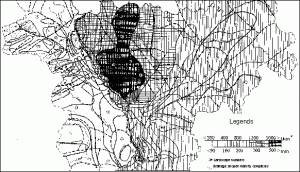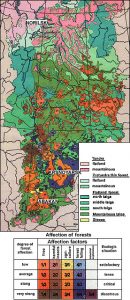Sukachev Institute of Forest, SB RAS, Krasnoyarsk
Head of the Institute:
Eugene A.Vaganov, Academician of the RAS
Akademgorodok, Krasnoyarsk, 660036, Russia
Tel.: (3912) 494092, Fax: (3912)433686
email: san@maps.ifor.krasnoyarsk.su,
ifor@.krsk.infotel.ru
Principal researchers:
D.A.Burakov, Doctor of Geological Sciences, Professor
E.N.Kalashnikov, Ph.D.
E.S.Markova, Ph.D., Reader
D.I.Kravlsov
Project objectives
- To precise and to detail scenarios of climate changes in taiga landscapes of Middle Siberia.
- To generalise and to supplement the existing notions of a mechanism of the main processes of hydrological cycle in the studied area.
- To assess the effect of climatic changes and anthropogenic disturbance of forests on the main processes of hydrological cycle In taiga landscapes of Middle Siberia.
Background and significance of objectives
The authors of the project are known by their papers in landscape science, hydrology, hydrological forecasts, modelling of a river runoff, application of aerospace methods in hydrological prognoses and studying runoff in landscapes. The list of the main publications is given below.
To understand the theme it is necessary on the base of the obtained study results to give an assessment of climate change trends in Middle Siberia according to landscape zones and subzones using meteorological data of many years as well as other available sources.
Numerous investigations are devoted to studying the hydrological role of forests in different regions of Middle Siberia. The problems of transformation of hydrological cycle under anthropogenic stress were studied much poorer. The most part of studies deals methodically with not the total runoff but only with a surface and subsurface runoff which is written at the water balanced plots and makes only a small part of the total runoff. The results of the last fundamental research devoted to methodical bases of assessing anthropogenic changes or water balance and runoff in the forests did not find their reflection in publications on forest hydrology of Middle Siberia. Thus, a pressing need arose to generalise, to supplement and in some cases to overestimate the existing concepts about mechanism of the main processes of the hydrological cycle for the area studied, and on the new basis to precise assessments of their transformation under climatic changes and anthropogenic stress.
Research plan: approaches and methods
- A complex system approach for studying the hydrological cycle in taiga landscapes.
- Assessment of a heat- and water supply of an area based on combined water- and heat balances.
- Building of physical and statistical dependencies for quantitative assessment of changes of hydrological cycle of the anthropogenic and climatic conditionality.
- Methods of hydrological analogy and interpolation, a landscape-hydrological approach, analysis of aerospace information.
- Hydrological and mathematical models of a runoff.
Expected results
Methodical bases, qualitative and quantitative assessments of trends of climatic and anthropogenic changes of hydrological cycle parameters in taiga landscapes of Middle Siberia.
List of publications of participants related to the project
-
Burakov D.A., Zemtsov V.A. Some peculiarities of a runoff forming in the forest zone of the West-Siberian plain under anthropogenic effect // Water resources of taiga. Irkutsk: Institute of Geography SB of the USSR Academy of Sci. – 1984. – P. 109-120.
-
Burakov D.A., Galakhov Y.P. et al. Snow- water- glacial resources of the upper Ob’ river basin and prognoses of a spring flood. – Tomsk: the Tomsk State University Press, 1986. – 400 p.
-
Burakov D.A., Avdeyeva Yu.Y. Technology of effective forecast of daily water discharge based on satellite information on snow cover (a case study of the Nizhnyaya Tunguska river ) // Meteorology and hydrology. – 1996. – ı 4. – P. 75-86.
-
Kalashnikov E.N. Monitoring of disturbance of Siberian forests // Siberian J. Ecol. – 1998. – ı 1. – P. 49-57. (In Rus.).
-
Kalashnikov E.N., Kravlsova V.I. The map “Disturbance of forests of the Krasnoyarsk Territory” // The Atlas “The Cosmic Methods of Geoecology”. Moscow, 1998.
-
Kalashnikov E.N. Study of forest landscapes by remote sensing methods. – Novosibirsk: Nauka, 1987.
Fig. 1. Solid and liquid drainage of the southern and middle taiga of Siberia; anthropogenic effects indicated
Fig. 2. Affected forests of Krasnoyarsk Territory and The Republic of Khakasia.


